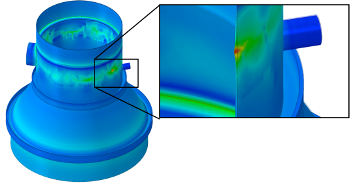Fitness-For-Service of a Vacuum Tower with Wall Thinning

ASME FFS-1 / API-579 Level 3 Assessment Avoids Unnecessary Downtime
 In 2011, Becht Engineering was approached by a major refiner on the US West Coast to assist with the evaluation of two vacuum towers. Due to a process change, corrosive products were occurring at elevations in the towers where there was insufficient protection against corrosion. As a result, significant and extensive corrosion was measured. In many places, the wall thickness was less than the tmin established by conventional engineering assessments.
In 2011, Becht Engineering was approached by a major refiner on the US West Coast to assist with the evaluation of two vacuum towers. Due to a process change, corrosive products were occurring at elevations in the towers where there was insufficient protection against corrosion. As a result, significant and extensive corrosion was measured. In many places, the wall thickness was less than the tmin established by conventional engineering assessments.
Trevor Seipp, P.Eng. from Becht Engineering’s office in Calgary, Canada took on the job of evaluating the towers’ fitness-for-service. Typical evaluations of local thin areas in pressure vessels and piping are performed frequently and easily by skilled engineers. However, this particular situation was unique in that the corrosion was extensive – the corrosion map data for each tower had over 20,000 data points, and the normal operating condition for the vessel was external pressure (vacuum).
Trevor was able to quickly write a custom-made subroutine for our finite element analysis software, ABAQUS, that used the corrosion map to modify a finite element model to accurately simulate the corrosion extent with the actual remaining wall thickness. Using this tool, we were also able to simulate future uniform corrosion forecasts. Finally, we performed an elastic-plastic stress analysis that also accurately simulates buckling failures. It is vitally important to evaluate for buckling failures because that is the primary failure mechanism of vessels that operate under external pressure (vacuum).
Each tower was evaluated for fitness-for-service at the current corrosion state. Each tower was fit-for-service. Future uniform corrosion forecasts were also evaluated from the current time to the next scheduled maintenance outage. One tower was fit-for-service at the next maintenance outage. The other tower would not meet the required design margin at the next maintenance outage, but was not predicted to actually fail. However, state law and good engineering practice require compliance with the required design margin. Accordingly, a fillet-welded lap patch repair was designed. This repair was also simulated in the analysis to determine if it would be suitable; and it was.
All of this work was completed in less than 3½ weeks; on-time and under-budget. Becht Engineering’s report was presented to the State Pressure Vessel Regulator and as a result the refinery was permitted to continue operating. The scheduled maintenance outage has since occurred and there were no further incidents with the vacuum tower.
